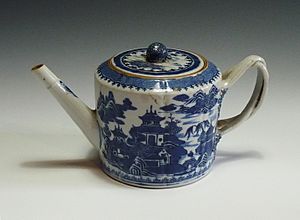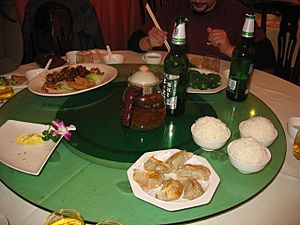Customs and etiquette in Chinese dining facts for kids
Chinese dining customs are the traditional ways people eat and behave during meals in Greater China. These customs, especially from the Han people, have spread across East Asia. They cover everything from where guests sit to how the bill is paid. Learning these customs can make your dining experience more fun and respectful!
Contents
Setting the Table: What to Expect
In most traditional Chinese meals, everyone shares the dishes. While square or rectangular tables work for small groups, round tables are best for larger gatherings, especially in restaurants. This makes it easy for everyone to reach the food. Many large tables have a Lazy Susan turntable in the middle. This spinning tray helps pass serving dishes around easily.
A basic place setting includes a small teacup and a large plate with a small, empty rice bowl. You'll also find a set of chopsticks, usually on the right side of the plate, and a soup spoon. Sometimes, there's a chopstick rest, a glass for water or wine, and a smaller glass for baijiu (a strong Chinese drink). A small dish might be there for dipping sauces.
At home or in casual restaurants, you might get paper tissues as napkins. Nicer restaurants often provide cloth napkins, similar to Western dining.
Unlike some Western restaurants, you won't usually find salt, pepper, or sugar shakers on the table. Instead, you might see bottles of soy sauce, vinegar, or hot sauce. Black vinegar is popular in northern China, especially for dipping dumplings.
Who Sits Where? Formal Seating Rules
At a formal Chinese dinner, there's a special way people sit. It's based on who is oldest or most important. The seat of honor is usually in the center, facing east or the room's entrance. This seat is for the host or the oldest person. Important guests sit close to this main seat. People with less important roles sit further away. The least important seat is usually near the kitchen or service door.
In a big banquet hall with many tables, the main table is the one furthest from the entrance. The tables on the left of the main table are considered second, fourth, sixth in importance, and so on. Tables on the right are third, fifth, and seventh. Guests are seated according to their status and how they relate to the host.
How a Chinese Meal Flows
Meals in China can vary a lot by region. However, most full dinners follow a similar order for dishes and drinks.
Drinks to Start and Sip
Hot tea is almost always served. It might be on the table before you sit down or brought right after. You can drink tea throughout the meal. Water, juice, or other drinks might also be served. If someone refills your tea, you can say "thank you" (Chinese: 谢谢; pinyin: xiexie). If you're in the middle of a conversation, you can politely tap the table twice with two bent fingers. This quietly thanks the person and shows you've had enough.
Toasting with drinks like Baijiu is common in northern China and at formal events. Everyone is expected to toast each other at least once. It's considered rude to refuse a toast. If there's no server, the youngest person at the table usually refills everyone's cups.
Small Bites: Appetizers
Appetizers are the first things to arrive. These are usually two or more small dishes. They might have boiled peanuts, crispy fried noodles, or similar snacks. You can munch on these while you order your main dishes or wait for other food to come out.
Warm and Comforting: Soup
A hot soup might be served as one of the dishes. In some areas, soup comes at the start of the meal. In others, it's served near the end. For smaller meals, especially at home, soup might even replace other drinks.
Unlike Western meals, Chinese dinners usually have many main dishes that everyone shares. Often, there's one shared dish for each person at the table. A special event, like a graduation or wedding, might have over ten dishes! Sometimes, an odd number of dishes is served for good luck.
The dishes vary greatly depending on the restaurant's cuisine. China has eight main regional cuisines, each with different cooking styles, ingredients, and flavors. Some famous ones are Cantonese, Sichuan, and Hunan.
Small bowls of white steamed rice are provided. People often put food from the shared dishes over their rice, letting the sauces flavor it. You eat the rice little by little with the other dishes. You only eat it separately if you're still hungry after all the other food is gone.
Finishing Up: The Last Course
Near the end of the meal, a filling dish like noodles, Chinese dumplings, or baozi (steamed buns) might be served. This makes sure everyone is completely full. In very formal settings, people might only take a small amount of this last dish. This is to avoid suggesting that the host didn't provide enough food.
Sweet Treats: Dessert
Casual meals might not have a dessert, or they might offer sweet foods that are favorites of the diners. Restaurants often offer fresh fruit, like citrus slices, or fresh or canned pineapple.
Other common desserts include tapioca or rice pudding. You might also find a hot or cold soup flavored with sweet red beans. Ice cream can be offered, often with flavors like ginger, sweet red beans, or a delicate tea.
Fortune cookies are rarely found in real Chinese restaurants, even in North America where they were invented. They are seen as a lighthearted treat, good for casual gatherings with close friends and family. Fancier restaurants might offer mints or chocolates to freshen your breath.
Good Manners at the Table
Eating is a very important part of Chinese culture. Eating out is a common way to honor guests, socialize, and build friendships.
Even though there were efforts to change traditional manners in the past, proper etiquette is still very important to many Chinese people. Good manners are believed to bring luck and show good education. Bad manners can bring shame. For example, misusing chopsticks at a formal dinner might embarrass your parents, who taught you.
How to Behave Personally
Since chopsticks and spoons are used instead of forks and knives, Chinese food is often served in bite-sized pieces. Or, dishes like fish or hong shao rou are cooked so tenderly that they can be easily pulled apart. Here are some common rules:
Chopsticks are only for picking up food. It's not polite to spear food with them, though some people do if the food is too slippery. It's also rude to point at people with chopsticks, pick your teeth, bang bowls, move bowls, chew on them, or wave them around. Hold them so the ends are even, and never hold one in each hand.
When you're not using your chopsticks, place them on a chopstick rest if there is one. Otherwise, lay them across your bowl or plate. Never leave them sticking straight up out of your food. This reminds people of incense sticks used at funerals.
Traditionally, you should hold chopsticks in your right hand. You can hold your bowl on the table or pick it up close to your mouth with your left hand. Or, at least keep your left hand on the table, not in your lap. (Eating with chopsticks in your left hand or without both hands on the table used to be seen as rude, but this view is changing.) However, it's never rude to lift a rice bowl with one hand and use chopsticks with the other to scoop rice into your mouth.
Dipping sauces like soy sauce or sesame oil are sometimes served in small dishes. This lets you dip pieces of food as you like. However, very high-quality restaurants might not provide them. The idea is that perfectly cooked food doesn't need extra sauces, and you should enjoy it as the chef prepared it.
It's considered good to finish all the food on your plate or in your bowl. If there's a lot of food left in the serving dishes after a meal, it's often a compliment to the chef to ask for it to be packed up. You can then enjoy it later at home.
Sharing Food: Communal Eating
Sharing meals is very common in China. This includes casual meals with friends and family, as well as formal banquets for special events. Shared meals let everyone try more dishes than if they ordered individually.
Sometimes, at formal meals, you'll see special communal serving chopsticks (公筷, gongkuai). These chopsticks are only for taking food from the shared dishes. They are often longer and fancier than your personal chopsticks (普通筷, putongkuai).
There might be one set of communal chopsticks per dish or per course. If there are no gongkuai on the table, it's fine to ask for them. With more awareness about food safety, health groups encourage using serving utensils, even at family meals.
It's very rude to dig around in a serving dish for a specific piece of food. You should always take the piece closest to you. This shows fairness and sharing. It's also impolite to take most of a dish for yourself before others have had a chance to try it. So, it's common to take a small amount the first time and think of others when taking a second helping.
You should never take the last piece of food from a communal dish without asking permission. If someone offers you the last bit of food, it can sometimes be considered rude to say no.
The Spinning Tray: Lazy Susan
A Lazy Susan is a large, round, spinning platform in the middle of a table. It helps everyone easily share many dishes. Lazy Susans can be made of glass, wood, or plastic.
Usually, all the dishes for a course are brought out together and placed around the edge of the Lazy Susan. If the turntable is very large, a decoration might be in the center. Sometimes, shared condiments like soy sauce or hot sauce are placed there.
If dishes come out one at a time, or if there's a special treat, they are usually served to the guest of honor first. Then, the Lazy Susan is rotated clockwise around the table. The host often waits to serve themselves last. Dishes are usually not taken off the Lazy Susan and placed on the table. At most, a person might hold a dish up while serving themselves, then put it back on the tray. People try not to move the Lazy Susan when someone is taking food from a dish.
Drinks and Toasts
Water and other non-alcoholic drinks can be enjoyed anytime. However, in formal settings, alcoholic drinks are usually only consumed during toasts. A small toast might be followed by a sip of wine or beer. But a baijiu toast often ends with Ganbei! (干杯), which means "drain the glass!" Ideally, glasses are refilled right after a toast, ready for the next one.
In casual settings, people can order their favorite drinks. Carbonated drinks or beer are often ordered, but many people are happy with tea or hot water.
Paying the Bill
The bill for the meal is given at the end, after all the food and drinks. In most Chinese restaurants, you don't need to leave a tip unless it's clearly stated. If a tip is required, it's usually already added to the bill. However, in Chinese restaurants in North America, tips are usually expected, just like in other restaurants there.
It's common to see families argue over who gets to pay the bill. The person who pays shows generosity, sincerity, and importance. If someone organizes a meal and invites guests, that person is usually honored with paying for the event.
|





